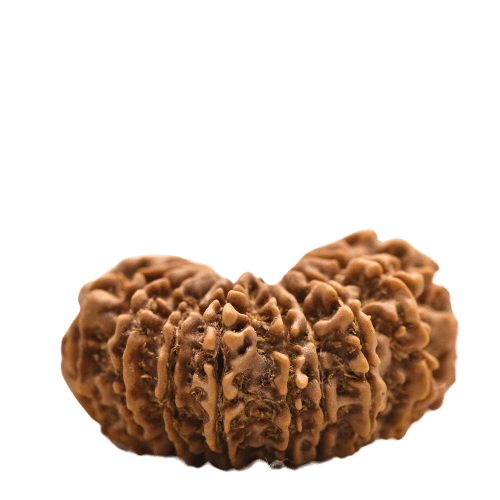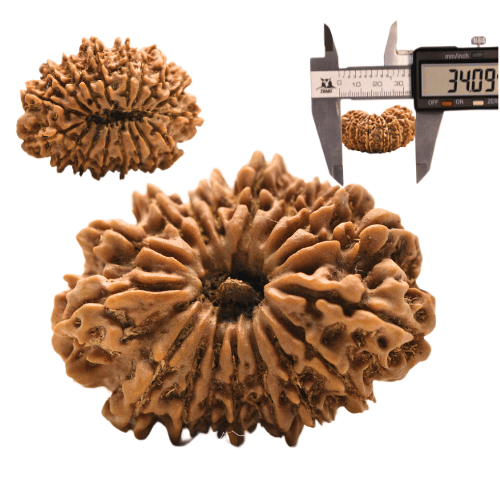My Store
14 Mukhi Nepali Rudraksha - Super Collector
14 Mukhi Nepali Rudraksha - Super Collector
Couldn't load pickup availability
What is Chaudah Mukhi, or 14 Mukhi Rudraksha?
• Known as Deva Mani, the 14-Mukhi Rudraksha is a symbol of Lord Hanuman. The strongest and most valuable jewel among all is this Rudraksha. That is thought to have come straight from Lord Shiva's third eye. Everyone among the Deities wears it.
• This Chaudah Mukhi Rudraksha bead is referred to as "Bead of the Gods," or "Deva Mani." It is known as the Ajna Chakra and is situated between Lord Shiva's two eyebrows.
Guidelines for using and caring for your 14-Mukhi Rudraksha
• Ideally, rudraksha should be gently scrubbed with water and lubricated with almond oil once a month, using a soft brush. Before donning the mala the next day, pray "Om Namah Shivaye."
• Use a tiny amount of a blend of mustard and sandalwood oils every Chaturdashi.
• Rudraksha beads or a mala should not be shared, traded, or transferred from one person to another once they have been worn.
•You should not wear when visiting a newborn, and when visiting cemeteries. Keep your Rudraksha mala and beads hidden from prying eyes. To extract the most, it must be kept hidden and a secret.
More details
Guidelines:
Guidelines for using and caring for your 14-Mukhi Rudraksha
•Ideally, rudraksha should be washed with water and gently brushed with almond oil once a month. Before donning the mala the next day, pray "Om Namah Shivaye."
•Use a tiny amount of a blend of mustard and sandalwood oils every Chaturdashi.
• Rudraksha beads or a mala should not be transferred, exchanged, or given from one person to another after they have been worn. Keep your Rudraksha mala and beads hidden from prying eyes. To extract the most, it must be kept hidden and a secret.
Specifics:
Related deity: Hanuman
Ruling Planet: Mars and saturan
Related Chakra: Ajna Chakra
Origin: It is said that the thirteen Mukhi Rudraksha is obtained from the fruit of the Rudraksha tree (14 Mukhi Rudraksha tree), which grows in some parts of South Asia, including Nepal (14 Mukhi Nepali Rudraksha) and Indonesia (14 Mukhi Indonesian Rudraksha)
Beej Mantra:
'Om Indrayah Namah'
'Om Kamadevaya Namah'
'Om Shukraye Namah'
Ajna Chakra Bead is a related chakra. Dimensions: 35–40 mm
Who is the 14- Mukhi Rudraksha wearer?
Scriptures state that a wearer of the 14 Mukhi has the right to make the proper choices at the appropriate time and location. The 14 Mukhi is good for protection, self-assurance, and inner strength when traveling. It is advantageous to traders, investors, risk managers, workers in the steel and iron industry, and businesspeople. It improves intuition, luck, and facilitates rash judgments, all of which lead to favorable consequences.
How should a 14-Mukhi Rudraksha be worn?
Especially, the 14-faced Rudraksha beads' method of relieving pain is the most significant when the many beads are draped around your necks. The energy network formed by the beads strung needs to be maintained with care since energy flows through each bead in a unique way. Rudraksha beads should be arranged in a specific way to ensure that the energy flow remains constant and undisturbed throughout each bead. Rudraksha beads are polarity-capacitor devices that store and transmit natural energy. This is likewise the case; the Sumeru beads that are strung on the beads' thread are crucial because they serve as a conduit for the body to receive energy. This is particularly valid for necklaces made of strung beads. In the instance of Nepali-made Rudraksha beads The term "Kantha mala," or bracelet, refers to this group of beads. It is called a mala, or bracelet, if it is constructed with Rudraksha beads that are imported from Java, Indonesia; some people refer to it as a Kanthi mala, or bracelet.
What is Chaudah Mukhi, or 14 Mukhi Rudraksha?
Deva Mani is the name given to the 14-Mukhi Rudraksha, a symbol of Lord Hanuman. The strongest and most valuable jewel among all is this Rudraksha. That is thought to have come straight from Lord Shiva's third eye. Everyone among the Deities wears it. This Rudraksha bead from Chaudah Mukhi is called "Deva Mani," which translates to "Bead of the Gods." It is known as the Ajna Chakra and is situated between Lord Shiva's two eyebrows.
- Description
What is Chaudah Mukhi, or 14 Mukhi Rudraksha?
• Known as Deva Mani, the 14-Mukhi Rudraksha is a symbol of Lord Hanuman. The strongest and most valuable jewel among all is this Rudraksha. That is thought to have come straight from Lord Shiva's third eye. Everyone among the Deities wears it.
• This Chaudah Mukhi Rudraksha bead is referred to as "Bead of the Gods," or "Deva Mani." It is known as the Ajna Chakra and is situated between Lord Shiva's two eyebrows.
Guidelines for using and caring for your 14-Mukhi Rudraksha
• Ideally, rudraksha should be gently scrubbed with water and lubricated with almond oil once a month, using a soft brush. Before donning the mala the next day, pray "Om Namah Shivaye."
• Use a tiny amount of a blend of mustard and sandalwood oils every Chaturdashi.
• Rudraksha beads or a mala should not be shared, traded, or transferred from one person to another once they have been worn.
•You should not wear when visiting a newborn, and when visiting cemeteries. Keep your Rudraksha mala and beads hidden from prying eyes. To extract the most, it must be kept hidden and a secret.
More details
Guidelines:
Guidelines for using and caring for your 14-Mukhi Rudraksha
•Ideally, rudraksha should be washed with water and gently brushed with almond oil once a month. Before donning the mala the next day, pray "Om Namah Shivaye."
•Use a tiny amount of a blend of mustard and sandalwood oils every Chaturdashi.
• Rudraksha beads or a mala should not be transferred, exchanged, or given from one person to another after they have been worn. Keep your Rudraksha mala and beads hidden from prying eyes. To extract the most, it must be kept hidden and a secret.
Specifics:
Related deity: Hanuman
Ruling Planet: Mars and saturan
Related Chakra: Ajna Chakra
Origin: It is said that the thirteen Mukhi Rudraksha is obtained from the fruit of the Rudraksha tree (14 Mukhi Rudraksha tree), which grows in some parts of South Asia, including Nepal (14 Mukhi Nepali Rudraksha) and Indonesia (14 Mukhi Indonesian Rudraksha)
Beej Mantra:
'Om Indrayah Namah'
'Om Kamadevaya Namah'
'Om Shukraye Namah'
Ajna Chakra Bead is a related chakra. Dimensions: 35–40 mm
Who is the 14- Mukhi Rudraksha wearer?
Scriptures state that a wearer of the 14 Mukhi has the right to make the proper choices at the appropriate time and location. The 14 Mukhi is good for protection, self-assurance, and inner strength when traveling. It is advantageous to traders, investors, risk managers, workers in the steel and iron industry, and businesspeople. It improves intuition, luck, and facilitates rash judgments, all of which lead to favorable consequences.
How should a 14-Mukhi Rudraksha be worn?
Especially, the 14-faced Rudraksha beads' method of relieving pain is the most significant when the many beads are draped around your necks. The energy network formed by the beads strung needs to be maintained with care since energy flows through each bead in a unique way. Rudraksha beads should be arranged in a specific way to ensure that the energy flow remains constant and undisturbed throughout each bead. Rudraksha beads are polarity-capacitor devices that store and transmit natural energy. This is likewise the case; the Sumeru beads that are strung on the beads' thread are crucial because they serve as a conduit for the body to receive energy. This is particularly valid for necklaces made of strung beads. In the instance of Nepali-made Rudraksha beads The term "Kantha mala," or bracelet, refers to this group of beads. It is called a mala, or bracelet, if it is constructed with Rudraksha beads that are imported from Java, Indonesia; some people refer to it as a Kanthi mala, or bracelet.
What is Chaudah Mukhi, or 14 Mukhi Rudraksha?
Deva Mani is the name given to the 14-Mukhi Rudraksha, a symbol of Lord Hanuman. The strongest and most valuable jewel among all is this Rudraksha. That is thought to have come straight from Lord Shiva's third eye. Everyone among the Deities wears it. This Rudraksha bead from Chaudah Mukhi is called "Deva Mani," which translates to "Bead of the Gods." It is known as the Ajna Chakra and is situated between Lord Shiva's two eyebrows.












